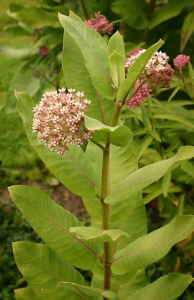Milkweed is the sole food source of monarch butterfly larvae (now I’d feel really guilty if I killed them for the vanity of my lawn).
According to Wikipedia, “Carl Linnaeus named the genus after Asclepius, the Greek god of healing, because of the many folk-medicinal uses for the milkweed plants.” You can use the milky sap (hence the name “milkweed”) as an antidote for poison ivy reaction and to remove warts. Incidentally, the sap of lots of sappy plants like aloe vera, dandelion and milkweed can be used to relieve poison ivy. Jewel weed is a well known one. Read more about this at at Natural Remedies .
During the May foraging lesson, I found milkweed to be edible and quite tasty. It is similar in flavor to asparagus, but in my humble opinion, tastier – milder and sweeter. It is closely related to a poisonous look alike – dogbane. According to Paul Tappenden of Suburban Forager this is how to tell them apart “Break a leaf and watch for the latex. If the stem is reddish and is coated with fine powder it is dog bane. Taste the leaf you just broke. Wait 30 seconds. If it is sweetish it is milkweed, if it leaves a bitter aftertaste on the back of the tongue, it is dogbane. Dogbane is poisonous.” Apparently, tasting it won’t hurt you. Paul has done this many times. We are looking forward to harvesting the milkweed flowers and making fritters with them at the next foraging event in June.


Posted on May 31, 2011 by Sustainable Sachi
0